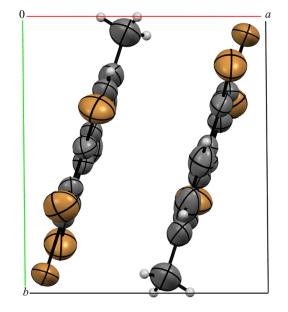3,6-二(2-吡啶基)-1,2,4,5-四嗪与3,4,5,6-四溴-1,2-脱氢苯的相互作用
IF 0.9
4区 化学
Q4 CHEMISTRY, ORGANIC
引用次数: 0
摘要
首次研究了3,6-双(2-吡啶基)取代的1,2,4,5-四嗪与原位合成的3,4,5,6-四溴-1,2-脱氢苯的相互作用。在这种情况下,除了预期的产物5,6,7,8-四溴-1,4-二(2-吡啶基)酞嗪外,还发现了两个替代转化产物,即1,2,3,4-四溴-6-甲基萘和3,6-二(2-吡啶基)吡啶。通过物理化学方法,包括x射线衍射数据,证实了产物的结构。提出了这种相互作用的可能机制。本文章由计算机程序翻译,如有差异,请以英文原文为准。

Interaction of 3,6-Bis(2-pyridyl)-1,2,4,5-tetrazine and 3,4,5,6-Tetrabromo-1,2-dehydrobenzene
The interaction of 3,6-bis(2-pyridyl)-substituted 1,2,4,5-tetrazine with 3,4,5,6-tetrabromo-1,2-dehydrobenzene obtained in situ from the corresponding anthranilic acid was studied for the first time. In this case, instead of the expected product, 5,6,7,8-tetrabromo-1,4-di(2-pyridyl)phthalazine, two alternative transformation products were found, namely 1,2,3,4-tetrabromo-6-methylnaphthalene and 3,6-di(2-pyridyl)pyridazine. The structure of the products was confirmed by physicochemical methods, including X-ray diffraction data. A possible mechanism for this interaction was proposed.
求助全文
通过发布文献求助,成功后即可免费获取论文全文。
去求助
来源期刊
CiteScore
1.40
自引率
25.00%
发文量
139
审稿时长
3-6 weeks
期刊介绍:
Russian Journal of Organic Chemistry is an international peer reviewed journal that covers all aspects of modern organic chemistry including organic synthesis, theoretical organic chemistry, structure and mechanism, and the application of organometallic compounds in organic synthesis.

 求助内容:
求助内容: 应助结果提醒方式:
应助结果提醒方式:


